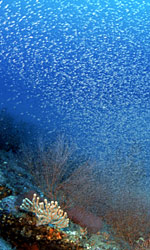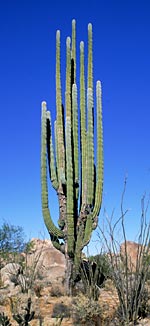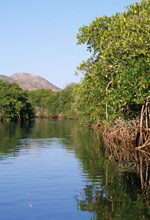![[Ocean Oasis Field Guide]](images/bnr-oo-field.gif)

![[Ocean Oasis Field Guide]](images/bnr-oo-field.gif) |  |
|
The basis for life lies in the organization and utilization of energy. There are two principal sources of usable energy in our solar system. One emanates from radioactive decay of elements within the Earth, and the other, from the sun. The former provides energy for tectonic movement, the genesis of oceanic crust and subduction and recycling of crustal materials. The latter, the sun's energy, fires the crucible of life and powers the transmission of energy to the atmosphere and ocean. These two sources that power life and all its systems are, in Baja California and the Sea of Cortés, more clearly defined than perhaps anywhere else on Earth. In the film, Ocean Oasis, the natural processes upon which all life depends are the central theme. | |
|
Tectonic Forces on Geological Evolution Baja California and the Sea of Cortés exist geographically because of plate tectonics. Movement of the Pacific and North American plates ripped the Baja peninsula and Southern California from mainland Mexico some six million years ago and opened up the Sea of Cortés in the process. The Pacific plate slid 200 miles northwards to smash Baja California into the continental mainland. The movement and collision of the plates created the soaring topography, the volcanic formations, and the extraordinary juxtaposition of land and sea. |
|
|
Solar Forces on Biological Evolution Solar energy is the basic source of energy for almost all of life. However, the life-supporting systems of photosynthesis are modulated by thermal energy from the sun which also drives the winds that, in turn, stir the oceanic currents. The circulation of winds and oceanic currents is the underlying mechanism that generated the incredible ecosystems of Baja California and the Sea of Cortés, and the motor that still maintains their existence. The cold California current, which runs southwards along the coast, is deflected westwards by the rotational movement of the Earth. The deflected surface layers are replaced by an upwelling of deeper water which is transported from the nutrient-rich layers of the ocean floor, bringing fertility to the surface. Local currents produce similar upwelling phenomena in the Sea of Cortés. Thus, the cold oceanic currents are a product of the ocean's upwelling and are the major cause of the great productivity of the regional seas. But cold seas are also the major cause of the aridity of the land, as the moisture-laden winds that run from the cold Pacific into the warm peninsula become hotter and hence drier. Only in the northern part of Greater Baja California does the land cool sufficiently in winter so as to cause condensation. This is the region of the chaparral, a unique evergreen scrub adapted to winter rains. |

|
|
The Effects of El Niño During El Niño years, trade winds weaken and equatorial westward currents decrease; warm oceanic waters accumulate along the coast of the American Continent, all the way from Peru to Mexico, and the California current loses momentum. The upwelling of nutrient-rich waters decreases, and the sea becomes warmer. Thus, the natural cycle becomes inverted; as the ocean currents slow down and warm up, the sea becomes less productive while the land is soaked by the abundant rainfall that originates from the now warm ocean waters. The famine of the sea is the feast of the land. Alternating between the land and the sea like a film in positive and negative, these pulses of productivity and sterility are the major driving forces of the ecosystems in the peninsula. Plants and animals are adapted, both in the sea and on land, to these seasonal variations. Some, like the cacti, the boojum trees, or the large marine mammals, evade critical periods through accumulation; they store essential products—water, sugars, and fat—that are then used during the time of want. Others, like the gray whales or the pronghorn antelopes, are capable of evading critical environments by migrating long distances, seasonally looking for places where environmental conditions and productivity are more adequate for survival. Finally, some rapid growers like the minute plankton, the desert ephemeral plants, or the anchovies and the sardines, have short-lived populations that are capable of growing at an immense rate during good years, while only a few may persist during stressful periods. Their populations numbers simply track the environmental bonanzas; their way to evade critical periods is simply to die off leaving behind propagules that will restart the life cycle when conditions improve. |
 |
|
The Effects of Biological Diversity These opportunistic species play an immense role in the ecological web of the Sea of Cortés and the Gulf of California. The miniature plankton and the small sardines and anchovies are at the base of the food chain in the ocean. Their rapid population surges and collapses with changing environmental conditions reverberate throughout the entire ecosystem, generating periods of availability and famine. In a similar way, the desert annuals leave behind thousands of seeds that remain in the soil during critical periods until the next pulse of rainfall. These seeds are, indeed, the "plankton of the desert." A myriad of organisms, like ants, rodents, and birds, survive the dry spells by harvesting and consuming them. Granivory (the consumption of seeds) and not herbivory (the consumption of leaves) is at the base of the food chain in the desert, as those few plants that maintain leaves during dry spells usually endow them with toxic compounds or protect them with spines. The onset of rainy years brings to the desert a reproduction frenzy of desert annuals, and a subsequent seed-pulse that echoes throughout the entire desert food web. The high diversity of the Gulf of California is largely due to two phenomena:
|

|
Text by Exequiel Ezcurra
Photos: Bahía de La Concepción and Sierra de La Giganta—Bradford Hollingsworth;
Cloud of mycids—Ocean Oasis;
Cardón—Dale Clark;
Mangrove wetlands—Jon Rebman
Field Guide |
Site Index |
Ocean Oasis Introduction
San Diego Natural History Museum & PRONATURA
© 2000 CinemaCorp of the Californias